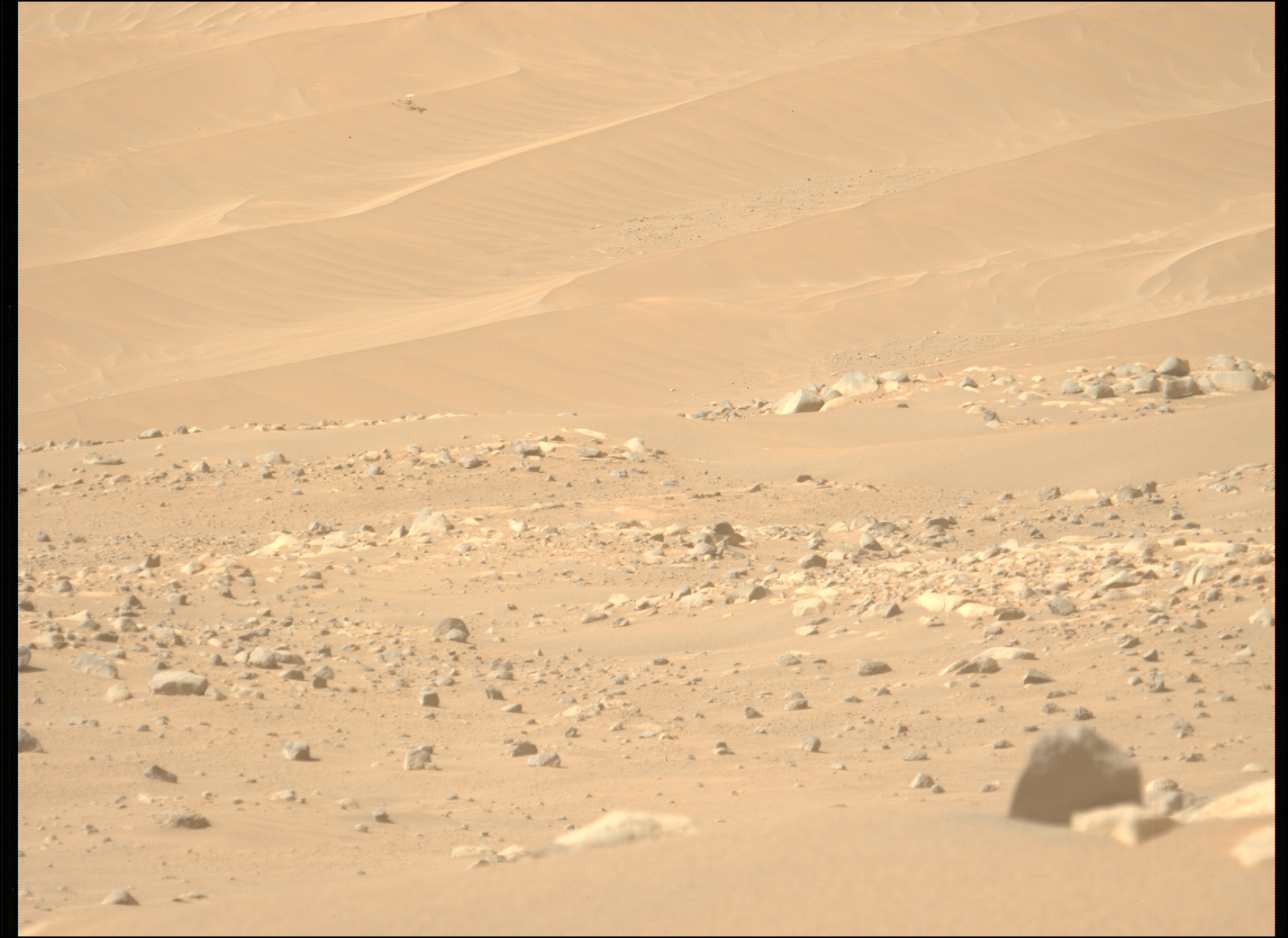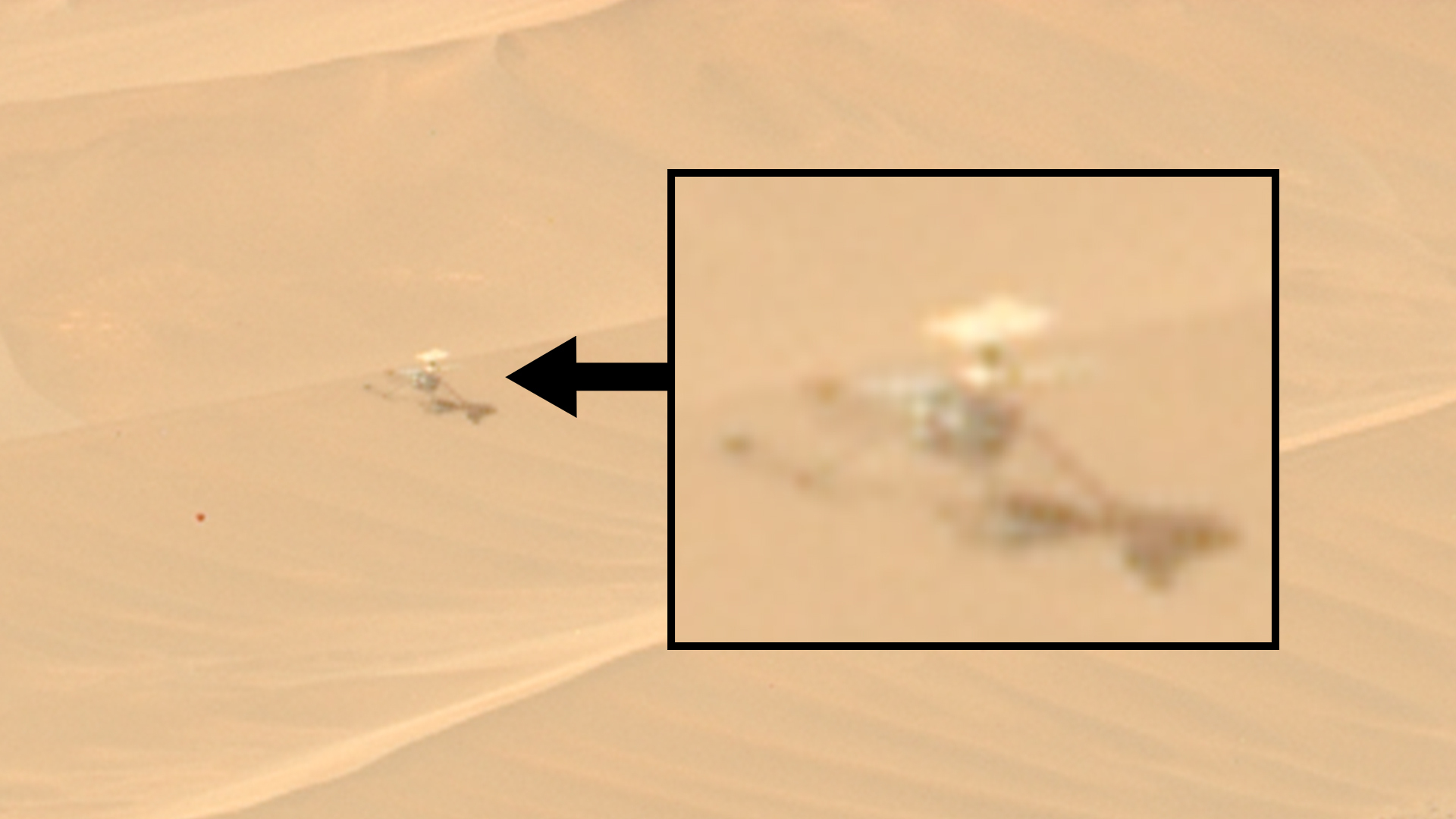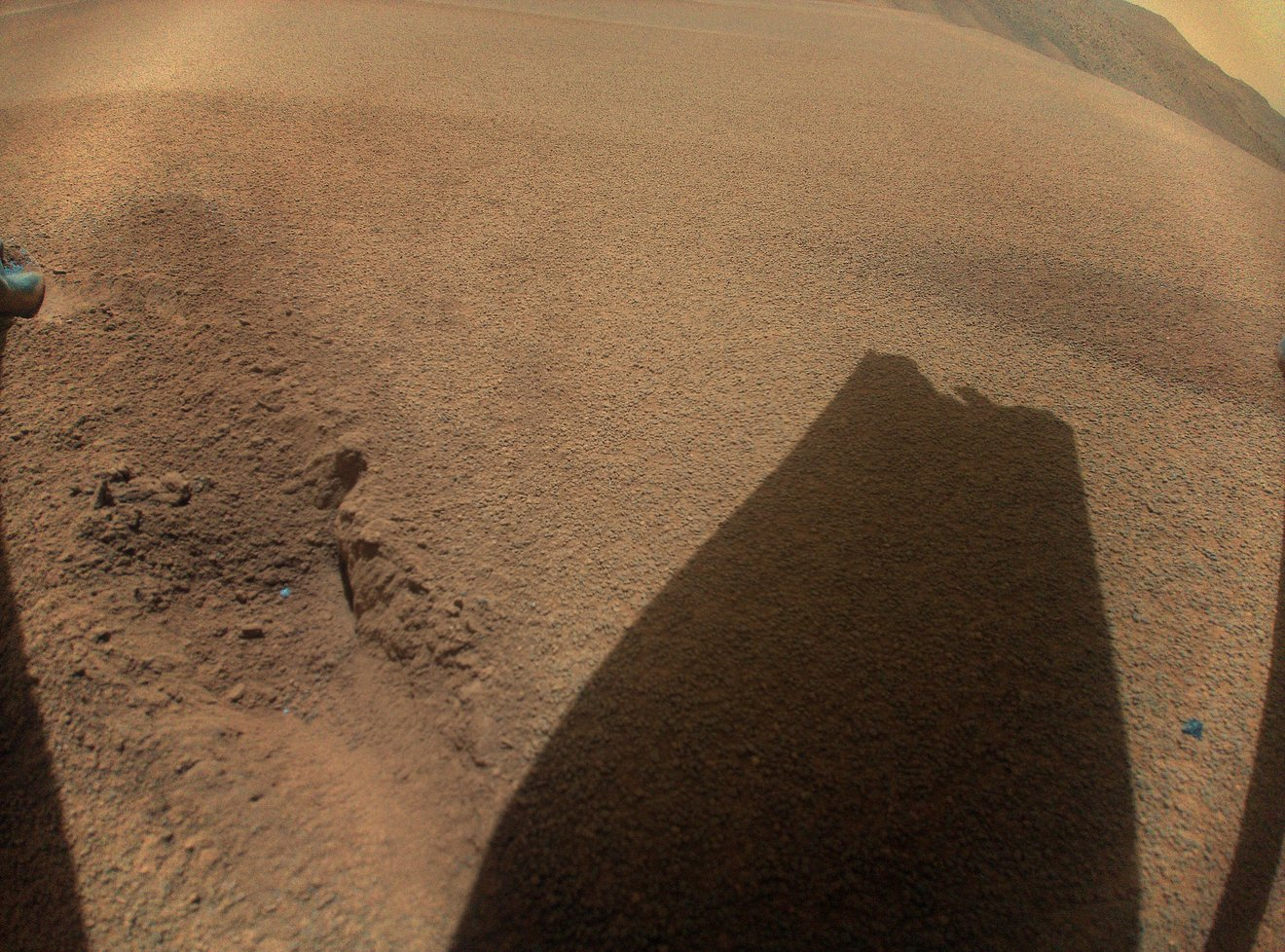NASA Ingenuity Mars helicopter, broken and alone, spotted by Perseverance rover on Martian dune (photo, video)
Ingenuity already looks lonely.
NASA's Perseverance Rover took a photo of its broken companion, the Ingenuity helicopter, as it sat alone on a dune.
In this most recent photo of Ingenuity, the dual-rotor 'copter can be seen motionless on a sandy dune in the background, as a barren, rocky Mars landscape fills the foreground.
The photo was taken on Feb. 4, 2024, at 1:05 p.m. local mean solar time, a little over two weeks since it suffered its mission-ending damage.
Related: NASA to 'wiggle' broken Ingenuity Mars helicopter's blades to analyze damage

Ingenuity suffered damage to its rotors during a flight on Jan. 18 as it made a landing on a featureless, "bland" patch of sandy Martian landscape. The helicopter usually makes use of landscape features such as rocks to help it navigate, but its 72nd flight found the drone without visual cues.
The Jet Propulsion Laboratory (JPL) is still analyzing the damage to Ingenuity's blades, but regardless of what JPL finds, the helicopter's mission has officially come to an end now that it's no longer capable of flight.
Ingenuity landed alongside its robotic companion, the Perseverance rover, on Feb. 18, 2021. When it took to the Martian skies in April 2021, Ingenuity made history by conducting the first flight of a powered aircraft on another planet.
Get the Space.com Newsletter
Breaking space news, the latest updates on rocket launches, skywatching events and more!
The Ingenuity-Perseverance duo has been exploring an area known as Jezero Crater ever since, discovering signs of ancient bodies of water on the Red Planet that may have once harbored life billions of years ago. Ingenuity served as a scout for Perseverance, identifying areas of interest for the rover to explore.

In recent weeks as NASA and JPL have been coming to terms with the end of Ingenuity's groundbreaking mission, agency leaders have praised the helicopter and the teams behind it.
"We couldn't be prouder or happier with how our little baby has done," said Teddy Tzanetos, Ingenuity Project Manager at JPL, during a livestreamed tribute to the helicopter on Jan. 31. "It's been the mission of a lifetime for all of us. And I wanted to say thank you to all of the people here that gave their weekends, their late nights. All the engineers, the aerodynamic scientists, the technicians who hand-crafted this aircraft."

Tiffany Morgan, NASA's Mars Exploration Program Deputy Director, added that Ingenuity leaves behind a legacy that could pave the way for future aerial missions on other worlds.
"The NASA JPL team didn't just demonstrate the technology, they demonstrated an approach that if we use in the future will really help us to explore other planets and be as awe-inspiring, as amazing, as Ingenuity has been," Morgan said during the livestream.
NASA is already developing another drone destined for another world, the nuclear-powered Dragonfly, to someday explore Saturn's largest moon, Titan. The agency expects Dragonfly to launch no earlier than 2028.
Join our Space Forums to keep talking space on the latest missions, night sky and more! And if you have a news tip, correction or comment, let us know at: community@space.com.

Brett is curious about emerging aerospace technologies, alternative launch concepts, military space developments and uncrewed aircraft systems. Brett's work has appeared on Scientific American, The War Zone, Popular Science, the History Channel, Science Discovery and more. Brett has English degrees from Clemson University and the University of North Carolina at Charlotte. In his free time, Brett enjoys skywatching throughout the dark skies of the Appalachian mountains.
-
Cdr. Shepard Aren't we all broken and alone?Reply
I don't know what Brett had to hit me right in the feels with this headline. -
Cdr. Shepard Reply
I'm sure they'll at least try. Engineering will consider that a key lesson learned.Cisventure Astronot said:I wonder if they'll try to picture the damage on the blades. -
iMaxPlanck You hang in there, lil fella! The people of Earth are rallying to bring you home safely.Reply -
AxE Reply
They have! They wiggled the rotor and were able to confirm that at least two blades grazed the surface as it attempted to land in a "bland" dune slope with apparently too little contrast to navigate safely. Lesson learned!Cisventure Astronot said:I wonder if they'll try to picture the damage on the blades.
https://forums.space.com/threads/nasa-to-wiggle-broken-ingenuity-mars-helicopters-blades-to-analyze-damage.65076/Cisventure Astronot said:I wonder if they'll try to picture the damage on the blades. -
Cisventure Astronot Reply
The article you linked said that they will do the wiggle, not that they have. I was wondering if they'll try to picture the damage with Perseverance instead of the wiggle, but they might have already done it by now.AxE said:They have! They wiggled the rotor and were able to confirm that at least two blades grazed the surface as it attempted to land in a "bland" dune slope with apparently too little contrast to navigate safely. Lesson learned!
https://forums.space.com/threads/nasa-to-wiggle-broken-ingenuity-mars-helicopters-blades-to-analyze-damage.65076/ -
iceiggle Reply
Nobody on earth, including NASA and SpaceX, will try to retrieve the Ingenuity helicopter. NASA may build another helicopter with proximity sensors on the tips of its bladesiMaxPlanck said:You hang in there, lil fella! The people of Earth are rallying to bring you home safely.








